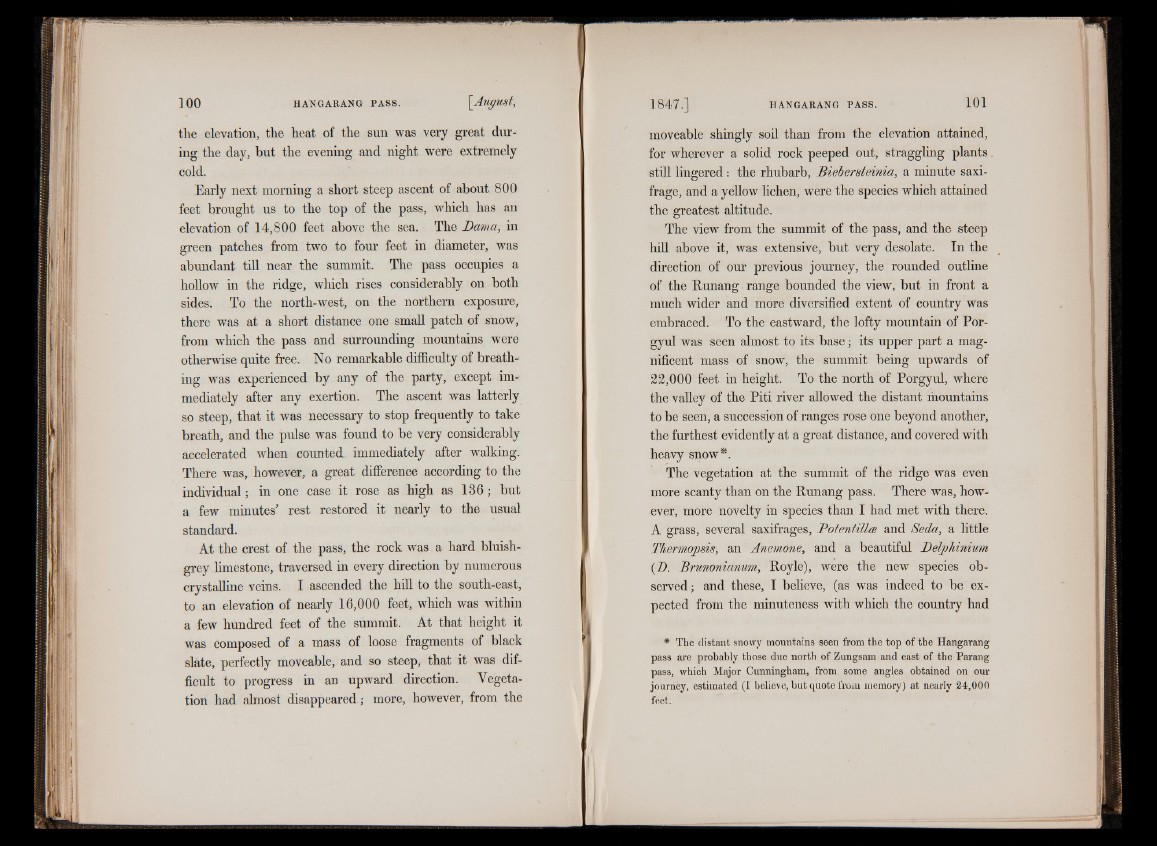
the elevation, the heat of the sun was very great during
the day, but the evening and night were extremely
cold.
Early next morning a short steep ascent of about 800
feet brought us to the top of the pass, which has an
elevation of 14,800 feet above the sea. The Dama, in
green patches from two to four feet in diameter, was
abundant till near the summit. The pass occupies a
hollow in the ridge, which rises considerably on both
sides. To the north-west, on the northern exposure,
there was at a short distance one small patch of snow,
from which the pass and surrounding mountains were
otherwise quite free. No remarkable difficulty of breathing
was experienced by any of the party, except immediately
after any exertion. The ascent was latterly
so steep, that it was necessary to stop frequently to take
breath, and the pulse was found to be very considerably
accelerated when counted immediately after walking.
There was, however, a great difference according to the
individual; in one case it rose as high as 136 ; but
a few minutes’ rest restored it nearly to the usual
standard.
At the crest of the pass, the rock was a hard bluish-
grey limestone, traversed in every direction by numerous
crystalline veins. I ascended the hill to the south-east,
to an elevation of nearly 16,000 feet, which was within
a few hundred feet of the summit. At that height it
was composed of a mass of loose fragments of black
slate, perfectly moveable, and so steep, that it was difficult
to progress in an upward direction. Vegetation
had almost disappeared f more, however, from the
moveable shingly soil than from the elevation attained,
for wherever a solid rock peeped out, straggling plants.
still lingered: the rhubarb, Biebersteinia, a minute saxifrage,
and a yellow lichen, were the species which attained
the greatest altitude.
The view from the summit of the pass, and the steep
hill above it, was extensive, but very desolate. In the
direction of our previous journey, the rounded outline
of the Runang range bounded the view, but in front a
much wider and more diversified extent of country was
embraced. To the eastward, the lofty mountain of Por-
gyul was seen almost to its base; its upper part a magnificent
mass of snow, the summit being upwards of
22,000 feet in height. To the north of Porgyul, where
the valley of the Piti river allowed the distant mountains
to be seen, a succession of ranges rose one beyond another,
the furthest evidently at a great distance, and covered with
heavy snow*.
The vegetation at the summit of the ridge was even
more scanty than on the Runang pass. There was, however,
more novelty in species than I had met with there.
A grass, several saxifrages, Potentillce and Seda, a little
Thermopsis, an Anemone, and a beautiful Delphinium
(D. Brunonianum, Royle), were the new species observed;
and these, I believe, (as was indeed to be expected
from the minuteness with which the country had
* The distant snowy mountains seen from the top of the Hangarang
pass are probably those due north of Zungsam and east of the Parang
pass, which Major Cunningham, from some angles obtained on our
journey, estimated (I believe, but quote from memory) at nearly 24,000
feet.